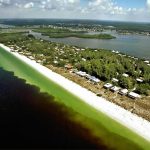New Study Reveals, When Hungry, Gulf of Mexico Algae Go Toxic
 When Gulf of Mexico algae don’t get enough nutrients, they focus their remaining energy on becoming more and more poisonous to ensure their survival, according to a new study by scientists from North Carolina State University and the National Oceanic and Atmospheric Administration.
When Gulf of Mexico algae don’t get enough nutrients, they focus their remaining energy on becoming more and more poisonous to ensure their survival, according to a new study by scientists from North Carolina State University and the National Oceanic and Atmospheric Administration.
The study shows that harmful and ubiquitous Karenia brevis algae, which cause red tide blooms across the Gulf of Mexico, become two to seven times more toxic when levels of phosphorus, a major algal nutrient found in fertilizers and human waste, are low. Like wearing a suit of armor, producing highly toxic cells allows the algae to defend themselves against opportunistic waterborne grazers like zooplankton.
Red tide blooms in the Gulf are linked to fish kills and other ecological and economic damage in the region, and are also linked to respiratory ailments in humans. These blooms occur annually in the Gulf, but it’s hard to predict where or when they’ll occur or how long they’ll last.
Drs. Rance Hardison and Damian Shea (University Director of the SE CSC), co-authors on a paper appearing online in the journal PLOS ONE, say that the findings could help coastal managers make better predictions about the harmful effects of red tide blooms.
Also, read here for NCSU Press Release.
- Categories: